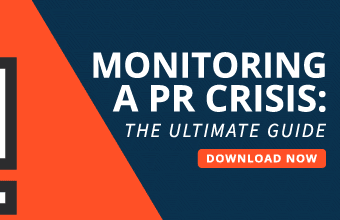As a PR pro, you’ve seen how a strong brand reputation can foster customer trust and encourage business success.
You’ve also seen how reputational damage can negatively affect customer sentiment and a business’s bottom line.
That’s why it’s your job to help your clients maintain a positive public image. And one of the most effective ways you can do that is by taking a proactive approach to crisis management.
Let’s take a closer look at how you can protect your clients’ public reputation with proactive crisis management strategies.
Highlight potential crises
Uncover your clients’ top vulnerabilities as soon as you start working with them.
What could create a media outrage? What could cause customers to lose trust?
Each business model is at risk for specific crises. For example, a valet service provider would need to consider risks, such as car accidents or causing bumps and scratches. An educational institution would need to consider potential issues, such as a loss of funding or grades plummeting.
Consider your client’s key stakeholders, too — and the risks they face. You can also look through common complaints or past crises to pinpoint more vulnerabilities.
Get ahead of potential legal issues
Ask a lawyer to audit your clients’ businesses for potential legal issues.
Have them review contracts, systems, resources, and business registration to uncover vulnerabilities.
For instance, if a client has international employees, your lawyer may suggest they hire an Employer of Record (EOR) to handle the legal and administrative burdens of employing workers in different countries.
Or, if your client has a robust personal asset portfolio, your lawyer may suggest they restructure their business as an LLC to protect their assets in case of a lawsuit.
Some other types of legal issues businesses should avoid include …
- Contractual disputes: Make sure all contracts are clearly drafted, reviewed, and understood by all parties involved to prevent misunderstandings or disputes regarding terms, obligations, and responsibilities.
- Intellectual property infringement: Protect your intellectual property rights by registering trademarks, copyrights, and patents. Be vigilant against infringing on others’ intellectual property rights.
- Employment law violations: Comply with labor laws, including minimum wage, working hours, workplace safety, anti-discrimination, and harassment regulations.
- Data privacy and security: Safeguard sensitive information collected from customers, employees, and partners by implementing robust data protection measures and complying with relevant privacy regulations such as GDPR or CCPA.
- Regulatory compliance: Stay updated on industry-specific regulations and comply with government regulations at local, national, and international levels, such as environmental regulations, financial regulations, and industry standards.
- Product liability: Ensure products meet safety standards and are accurately labeled with warnings and instructions. Promptly address any product defects or recalls to minimize liability risks.
Take a solution-focused approach to negative reviews
Create a plan for immediately addressing negative reviews when they come in.
Unhappy customers can tank your client’s reputation and cause mistrust to spread.
You can handle this yourself or mentor someone in each client’s marketing department on how to stay ahead of negative commenters and reviews.
One of the simplest ways is by using social listening tools to monitor brand mentions and respond in real time. It’s also imperative to train clients on how to respond to customers with a solution-focused attitude and the utmost respect.
Here’s an example:
“Hi Tammy,
We’re so sorry to hear you received a damaged package. We’d like to make this right by shipping out a new product today.
Can you send us a quick email with your order number at (email here) or drop it below? We’ll get this shipped to you right away.”
Maintain transparent communication
Teach your clients how to lead with honest and thorough brand communication so their customers know what they’re getting and employees know expectations.
Consider a company like Buffer, a social media management brand. They value transparency so much that they titled their blog “Open Culture.” There, they include posts on everything about their brand, from finances to hiring practices to business operations.
Buffer also uses feedback and insights to develop new strategies to improve their culture, user experience, and employee retention.
A lack of transparency, on the other hand, can fuel outrage.
For instance, the lack of transparency and deceptive pricing tactics of vacation rental services has created discontent among travelers.
According to Cloudbeds’ report on accommodation industry insights, Airbnb was known for advertising low prices—and then tacking on additional fees at checkout. This caused mistrust and negative sentiment to spiral among their customers.
Following the discontent, the company took appropriate action and started displaying the total price with fees included early on. This transparent communication edit helped Airbnb slowly rebuild trust with its target audience.
Prevent negative media coverage
Coach your clients on how to stay out of the ring of fire with media outlets.
While this isn’t always possible, there are several measures they can take to encourage a positive brand image.
For example, they can:
- Engage in community outreach and corporate social responsibility initiatives.
- Build and maintain positive relationships with journalists and influencers.
- Use crisis communication plans to manage unexpected PR challenges.
- Monitor media coverage and social media conversations.
- Respond swiftly and effectively to negative publicity.
- Conduct media training for key spokespeople.
- Develop clear messaging and talking points.
Depending on the client, it might also be appropriate to discuss how to prevent poor behavior when at a public outing. This might include maintaining thoughtful and considerate communication, sticking to only a serving of alcohol, and modeling company values.
More on values in a bit.
Create contingency plans
Put a plan together for each client in case something goes wrong.
Having a plan in advance can help you put out fires faster and more strategically when they inevitably occur. This may include having a speech template prepared, stocking up on popular inventory, or integrating a rapid recovery time objective (a targeted timeframe to get things back to normal after a crisis).
For instance, by investing in rapid RTO, backups and redundant systems can recover quickly and safely. By stocking up on popular inventory, your client can ensure they have enough goods to sell in case of a spontaneous shopping rush.
*Pro-Tip: Be sure to regularly test your contingency plans to keep client team responses sharp.
Mentor clients to lead and maintain company values
Stress to your clients that they are walking billboards for their companies. Explain that the way they show up in the world, at home, and at work will affect their reputation and business success.
Encourage them to lead and maintain their company values so customers take their brand ethos seriously. For instance, if their company prides itself on food donations to local shelters, encourage them to volunteer at those locations quarterly or semi-annually.
If their company has an ambitious goal toward becoming eco-friendly, ask them to consider how they’re impacting the world both in and out of the office. Could they walk or bike to work instead? Could they start a recycling project in the employee lounge?
Discuss how they could embody their company values in real and practical ways.
Make sure clients are properly supported with enough employees and resources
Audit your clients’ internal setup to make sure they’re properly supported as a company. This includes having sufficient employees, resources, and tools to thrive as an organization and team.
Doing so is key to preventing employee strikes, long customer support response times, and operational bottlenecks that can cause reputational harm.
Crisis management in the healthcare sector, for example, is paramount. Negative experiences can easily impact a patient’s life and damage a hospital’s reputation. For example, understaffing can lead to decreased quality of care, increased patient wait times, and employee burnout.
This was especially true during the COVID-19 crisis. Hospitals had to secure travel nurses, PTs, radiologists, and other medical professionals at the last minute to support their facilities.
But the healthcare industry isn’t the only sector that needs proper support.
Online companies can also suffer drastically without proper management and systems in place—especially if they’re scaling at a rapid rate. The same is true for the hospitality industry, the retail industry, and the HR industry.
By helping your clients take internal support measures seriously, you can encourage businesses to operate like well-oiled machines, keeping them one step away from a crisis.
Wrap up
Being proactive is your client’s best line of defense against a potential crisis.
While you can’t prevent every crisis, you can still do your due diligence to put out as many fires as you can—before they start.
The rest is up to your clients.
For good measure, here’s a quick recap of the proactive approaches we covered in this guide:
- Highlight potential crises
- Get ahead of potential legal issues
- Take a solution-focused approach to negative reviews
- Maintain transparent communication
- Prevent negative media coverage
- Create contingency plans
- Mentor clients to lead and maintain company values
- Make sure clients are properly supported with enough employees and resources
That’s it for now, PR pros.
Here’s to your success!








